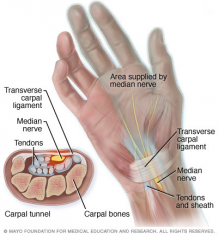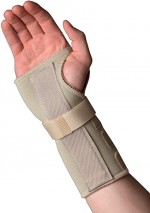YOUR PHYSIO
Condition directory
Carpal Tunnel Syndrome (CTS)
 Carpal tunnel syndrome is a common condition that can cause tingling, numbness or pins and needles or pain into the palm side of the hands and fingers.
Carpal tunnel syndrome is a common condition that can cause tingling, numbness or pins and needles or pain into the palm side of the hands and fingers.
You’ll usually feel it worst in the thumb, index and middle fingers, but sometimes it might feel like your whole hand is affected.
The symptoms tend to be worse at night and can disturb your sleep, but you may also notice it when you wake up in the morning. Hanging your hand out of bed or shaking it around will often help reduce the pain and tingling.
You may not notice the problem at all during the day, though certain activities such as writing, typing, DIY or housework, can bring on your symptoms.
There are eight small bones within your wrist which are known as the carpal bones. These naturally form a small space (tunnel) at the wrist joint for the median nerve and all of the forearm tendons to pass through. The top part of the tunnel is covered by a ligament known as the flexor retinaculum. The job of a nerve is to supply your hand with sensation and the ability to move.
.
What causes carpal tunnel syndrome?
It is not always known what causes the nerve to have a problem however there are many factors that increase your risk of carpal tunnel syndrome. These include:
- Pregnancy (this is due to hormonal changes and usually resolves a few months after childbirth)
- A previous broken or injury to the wrist
- Arthritis of the wrist (this can cause localised swelling that can compress the nerve)
- A family history of carpal tunnel syndrome
- Strenuous repetitive work with the hand
- Underactive thyroid gland
- Diabetes
- Obesity
Treatment of Carpal Tunnel Syndrome
Carpal tunnel syndrome can often resolve without any form of treatment. If there is a particular cause for your problem, e.g. underactive thyroid, then your symptoms may improve by treating that.
It can be helpful to modify or reduce any aggravating activities. Common activities that can provoke symptoms include activities which involve the wrist being held in a bent position (this closes down the space in the carpal tunnel) or sustained pressure over the wrist.
Please see examples of exercises which may be helpful to reduce your symptoms
Exercises for CTS
A resting wrist splint may be helpful. The splint (see diagram below) helps to keep the wrist in a neutral position and prevents the carpal tunnel from being closed down. The splint can also be worn during aggravating activities but it should not be worn all the time. It is usually recommended to try the splint for at least six weeks.

You can buy this type of splint from the internet or at a local pharmacy.
If a wrist splint does not improve your symptoms, a corticosteroid injection into the carpal tunnel can be trialled. This helps to reduce any inflammation within the carpal tunnel and is an effective treatment for about 80 percent of patients.
If your symptoms fail to improve or are particularly severe (this might be numbness that doesn’t go away or weakness in your hand muscles), then it’s important to seek advice from your GP. A surgical release of the nerve may be indicated. If your GP feels this is appropriate they can refer you on to the appropriate speciality.